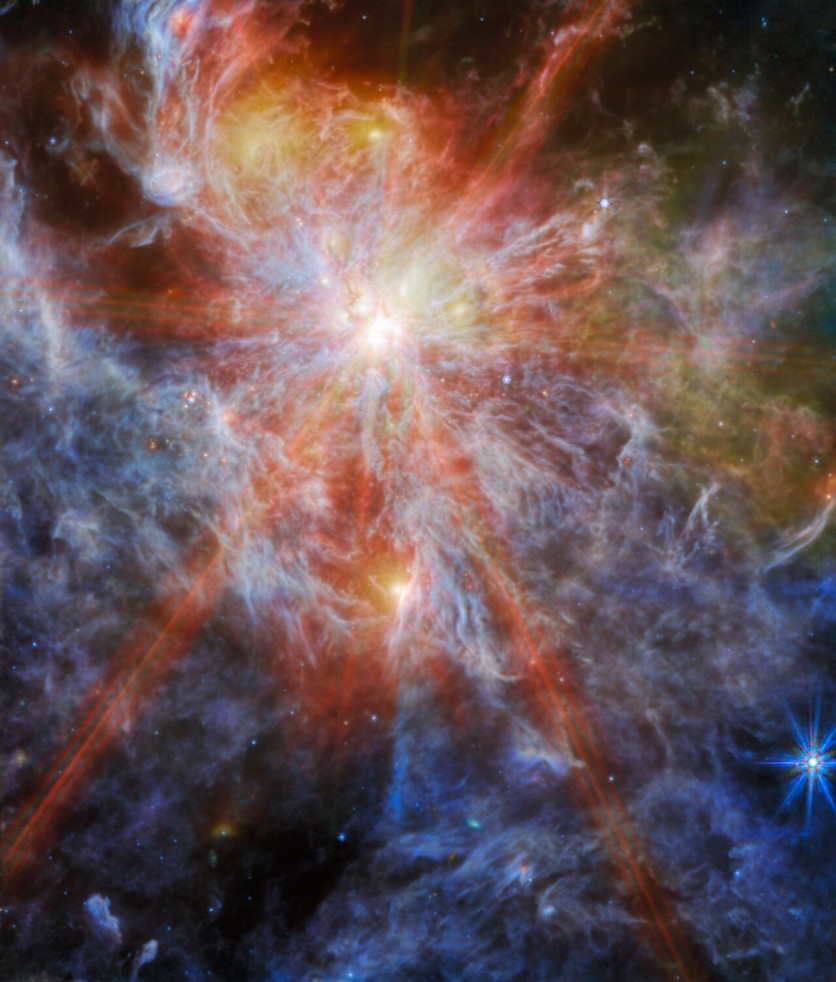NASA's James Webb Space Telescope has turned its infrared gaze towards an ionized interstellar atomic hydrogen region in the Large Magellanic Cloud (LMC), capturing a stunning and vibrant image.
The image, which showcases Webb's ability to capture the brightest and most colorful objects in space, features an H II region in the LMC, a satellite galaxy of our Milky Way. Identified as N79, this nebula consists of ionized interstellar atomic hydrogen, skillfully captured by Webb's Mid-InfraRed Instrumen

Luminous Young Star
At the heart of the image lies a luminous young star, surrounded by six prominent spokes of light that traverse the scene. The clouds surrounding the star exhibit intricate details, portrayed as layers of colorful wisps.
N79 is an expansive star-forming complex extending approximately 1630 light-years in the largely uncharted southwest region of the LMC. It is also considered a youthful counterpart to 30 Doradus, also known as the Tarantula Nebula, another recent target of Webb's observations, according to the European Space Agency (ESA).
Research indicates that N79 has displayed a star formation more efficiently than 30 Doradus by a factor of two over the past 500,000 years.
This image zooms in on the extensive molecular cloud complex known as N79 South (S1). The unique 'starburst' pattern enveloping this radiant phenomenon results from diffraction spikes, a typical occurrence in telescopes using mirrors to gather light.
Webb's hexagonal symmetry, created by its 18 primary mirror segments, generates six prominent starburst spikes visible around intensely bright and compact objects. In the extended wavelengths of light captured by MIRI, Webb's depiction of N79 unveils the radiant gas and dust within the region.
The mid-infrared light effectively penetrates the nebula, revealing the intricate details of the clouds - a feat unattainable with shorter wavelengths absorbed or scattered by dust grains. The image also exposes protostars still embedded in the field.
Read Also : NASA's James Webb Space Telescope Finds Something Weird Inside Mysterious 'Brick' in Milky Way
Colossal Star-Forming Areas
ESA noted that star-forming regions like N79 captivated astronomers due to their chemical composition, which was comparable to the colossal star-forming areas observed in the early Universe.
Webb's scrutiny of N79 provides astronomers with a valuable opportunity to juxtapose its findings with the deep observations of distant galaxies, offering insights into the evolutionary patterns of star formation.
Part of Webb's program involves studying the evolution of circumstellar discs and envelopes of forming stars, spanning various masses and evolutionary stages. Webb's extraordinary sensitivity allows scientists to detect planet-forming dust discs around stars similar to our sun's mass at the LMC's distance.
This captivating image represents 7.7-micron light in blue, 10 microns in cyan, 15 microns in yellow, and 21 microns in red, showcasing the telescope's capability to explore the cosmos across multiple wavelengths.
Related Article : NASA's Hubble Space Telescope Captures 'Butterfly Nebula' In Stunning Motion | Fun Facts About This Beautiful Space Butterfly

ⓒ 2025 TECHTIMES.com All rights reserved. Do not reproduce without permission.




